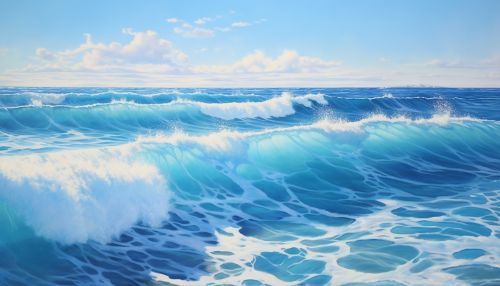Ocean Currents
Introduction
Ocean currents are continuous, directed movements of seawater generated by a number of forces acting upon the water, including wind, Coriolis effect, breaking waves, cabbeling, and temperature and salinity differences. They are primarily horizontal water movements. An ocean current flows for great distances and together they create the global conveyor belt, which plays a dominant role in determining the climate of many of the Earth’s regions.
Types of Ocean Currents
Ocean currents can be classified into two types: surface currents, which are driven by the wind and constitute about 10% of all the water in the ocean, and deep ocean currents, which make up the other 90% and are driven by differences in the water’s density.
Surface Currents
Surface currents, which include coastal currents and surface ocean currents, form the upper 400 meters of the ocean. These currents are generally measured in meters per second. They are primarily driven by major wind belts of the Earth. The Gulf Stream, the Kuroshio Current, and the Somali Current are examples of major surface currents.
Deep Ocean Currents
Deep ocean currents, also known as thermohaline circulation, are caused by differences in the water's density, which is controlled by temperature (thermo) and salinity (haline). This process is also known as thermohaline circulation. In the Earth's polar regions ocean water gets very cold, forming sea ice. As a result, the surrounding seawater gets saltier, increasing its density and causing it to sink. Deep ocean currents make up about 90% of the ocean and are much slower than surface currents.
Effects of Ocean Currents
Ocean currents have a significant impact on our planet. They regulate global climate, helping to counteract the uneven distribution of solar radiation reaching the Earth’s surface. Without currents in the ocean, the regional climate would be more extreme—super hot at the equator and frigid toward the poles—and much less of Earth’s land would be habitable.
Climate Regulation
Ocean currents play a crucial role in regulating the planet's climate. Warm currents like the Gulf Stream transport warm water from the tropics to the polar regions, while cold currents carry cold water from the poles to the tropics. This heat exchange regulates global climate and makes regions like Northwestern Europe much warmer than they would be otherwise.
Marine Life
Ocean currents also have a significant impact on marine life. They transport nutrients from the deep sea to the surface, supporting the growth of phytoplankton, the base of the marine food web. Currents also transport larvae and eggs, dispersing marine organisms across the ocean.
Historically, ocean currents have played a crucial role in navigation. Before the advent of modern navigation technology, sailors used their knowledge of ocean currents and wind patterns to navigate the seas. Even today, understanding ocean currents is essential for planning efficient and safe sea voyages.
Ocean Currents and Climate Change
Changes in ocean currents have a significant impact on climate change. As the Earth's climate warms, these changes could cause shifts in ocean currents, which could in turn lead to drastic changes in climate patterns. For instance, if global warming were to cause the Gulf Stream to slow down, this could make Northwestern Europe much colder than it is today.
Conclusion
Ocean currents play a crucial role in regulating the Earth's climate, supporting marine life, and aiding in navigation. However, changes in these currents due to global warming could have significant impacts on our planet. Understanding these currents and the forces that drive them is essential for predicting future climate change and protecting marine ecosystems.
See Also


